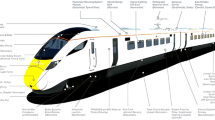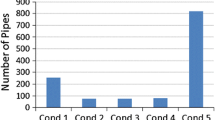Abstract
In many countries, inland waterway transport plays a significant role in the overall transport system. Navigation locks and dams are critical for inland waterways which regulate water and allow vessels to navigate. These infrastructures normally utilize large hydraulic steel structures, which are primarily of welded steel structures. Many of the critical welded joints of navigation lock gates have been in service for decades and are experiencing varying degrees of deterioration, mainly from fatigue. Inspection and maintenance of lock gates are expensive, generally requiring the complete closure of locks. Therefore, innovative strategies for the inspection and maintenance of lock gates are required. Fatigue cracks reflect the inherently poor fatigue performance of welded joints. Due to the cyclic loading nature of lock gates the fatigue of critical details requires assessment methods based on the reliability methods. Risk-based inspection planning are used for marine structures but seldom applied to inland navigation lock gates. This paper presents methods to update the failure probability of welded joints considering crack inspection data by using Dynamic Bayesian Network. Optimal inspection and repair plans can be evaluated by risk analysis, combining failure probabilities and associated expected costs for different events. In this study, a numerical example of the procedure of risk-based maintenance of a lock gate based on multiple critical welded joints is described. This reference case is a lock gate fabricated with five critical welded joints corresponding to different equivalent stress ranges. The conclusion is that risk-based maintenance of lock gates based on the optimization of the total expected cost is recommended.
You have full access to this open access chapter, Download conference paper PDF
Similar content being viewed by others
Keywords
1 Introduction
Hydraulic steel structures are very diverse. Depending on the type of structures and environmental conditions, their components and structures may be suffered from different degradations (fatigue damage). Fatigue damage usually occurs in stress-concentrated areas where localized stress is high. Lock gates are large hydraulic steel structures fabricated by welded vertically and/or horizontally members and steel plates. Due to complex geometry, there are imperfections and residual stresses during the manufacturing process. Welded components are particularly prone to fatigue rather than the base metal. Therefore, the fatigue strength analysis of welded structures at the design stage and operation stage as well as is of high practical interest. In this paper, a numerical example of the procedure of risk-based maintenance of a lock gate with multiple critical welded joints is described. This reference case is a lock gate fabricated with five critical welded joints corresponding to different equivalent stress ranges. These components are vulnerable to fatigue and are designed according to the “category E” of AASHTO.
2 Deterioration Modeling
Navigation lock gates, are subjected to cyclic loads. The primary fatigue load is the differential water head between the sides of a lock gate (called water head). It stands for the difference between water levels on the upstream and downstream sides of the lock gate. Since the water head is not exactly the same for each lockage due to seasonal flows of the river, the different stress ranges can be represented by an unique “equivalent stress range” (EUROCODE 2005). In the United States, the standard method for fatigue design and assessment of hydraulic steel structure is the nominal stress approach. The nominal stress approach is based on S–N curves when the capacity of welded steel joints related to the fatigue strength is represented by these S-N curves. There is no specific S-N curve available for hydraulic steel structures. The United States Army Corps of Engineers has recommended the code ETL 1100-2-584 (USACE-ETL-1110-2-584 2014) to perform fatigue assessment with the American Association of State Highway and Transportation Officials (AASHTO) code. Table 1 summarizes the parameters of the S-N.
The fatigue crack growth model is utilized for incorporating crack inspection results in assessing the failure probability. The most widely used model is the Paris law (Paris & Erdogan 1963). Table 2 presents the parameters of the fatigue crack growth model. Assuming that the geometry function (Y) is constant, crack size at time t can be calculated as shown in Eq. (1).
where a0 (t = 1) is the initial crack size, C and m are material parameters. \(\Delta \sigma\) is the equivalent nominal stress range used for fatigue analysis, n is the number of cycles per year and Bs is the load uncertainty.
Figure 1 shows the fatigue reliability curves for the five critical welded joints.
3 Dynamic Bayesian Network (DBN)
A Dynamic Bayesian Network (DBN) is a special class of Bayesian network, that represents the temporal evolution of variables over time. DBN was developed in the early 1990s by extending static belief-network models to more general dynamic forecasting models (Dagum et al. 1992). A DBN framework for stochastic modeling of deterioration process and updating the failure probability is proposed by Straub (Straub 2010). DBN is used to update the failure probability for critical welded joints of the lock gate. For a conservative way, it is assumed the lock gate fails when a critical welded joint fails.
The variable \({\text{q}}\) = \(\left( {1 - \frac{m}{2}} \right)CB_{s}^{m} \Delta \sigma^{m} Y^{m} n\pi^{m/2}\) (see Eq. (1)) is defined in order to reduce the dimension of the joint distribution and consequently the computational time. The crack depth at the end of each year can be expressed recursively as a function of the crack depth in the previous year as shown in Eq. (2).
By instantiating the inspection variables It in the DBN with the observed events at the times of inspection, the failure probability is updated considering the inspection outcomes.
The DBN representation including inspection results It for critical welded joints are shown in Fig. 2.
4 Risk-Based Decision Analysis
Risk-Based Inspection (RBI) is an attractive issue for hydraulic steel structures due to the increase of aging structures and that many failures are detected. The aim of RBI is to find a balance between the benefit of inspection, repair schedule versus failure cost. The failure probabilities using DBN are combined with the cost model.
Risk-based maintenance of the lock gate is performed according to three scenarios:
-
Optimal inspection and repair schedule of the lock gate based on the optimization of the expected cost of the independently critical welded joints.
-
Optimal inspection and repair schedule of the lock gate based on the optimization of the expected cost of the combined critical welded joints.
-
Optimal inspection and repair schedule of the lock gate based on the optimization of the expected cost of groups of combined critical welded joints.
The different unitary costs utilized in this numerical example are shown in Table 3. Because there is a difference of maintenance cost between a single welded joint and multiple welded joints, it is assumed that inspection cost and repair cost for an individual welded joint is equal to 50% of the inspection cost and repair cost that are used for multiple welded joints.
In the first scenario, the optimal schedule is performed for each welded joint independently.
As result, the expected cost for the lock gate is calculated by Eq. (3).
Figure 3 shows the result of the optimization of the total expected cost for the critical welded joints, A to E, independently.
The result of the optimization cost for each critical welded joint (A to E) is given in Table 4 and Fig. 3.
In the second scenario (combined critical welded joints), the inspection and repair of the five critical welded joints are performed with a similar time period to figure out the optimal schedule. Repair cost for each component is equal to the repair cost of the entire gate divided by the number of investigated critical welded joints. The failure probability of the lock gate \({P}_{fgate}\) is calculated by Eq. (4).
The total expected cost for the lock gate of the second approach is then calculated by Eq. (5)
where:
\(C_{insp}\) inspection cost,
\(C_{rj}\) repair cost for a critical welded joint,
\(C_{f}\) failure cost,
\(\alpha_{r}\) annual discounting rate,
\(P_{f}\) probability of failure,
\(P_{rj}\) probability of repair for a critical welded joint,
\(T_{i}\) year of inspection.
\(v\) number of critical welded joint.
Figure 4 shows the outcome of the optimal schedule the lock gate with multiple critical welded joints. The optimal expected cost of the gate is equal 2.38·104. The inspection and repair interval is of 6 years.
Thirdly, we consider two groups of combined critical welded joints. Critical welded joints having simultaneously inspection and repair time are combined together.
In this example, five critical welded joints are divided into two groups:
-
group 1 includes welded joint A and B with inspection and repair time interval is 7 years
-
group 2 includes welded joint C, D and E with time interval is 13 years.
Depending on the groups, the cost of inspection and repair are different. It is assumed that inspection and repair cost for group 1 and group 2 are equal to 80% and 90% of the inspection and repair cost that are used for the multiple welded joints (Table 3).
The procedure of the calculation in the third scenario is then similar to the second scenario (Eq. (4) and Eq. (5)) and the result is provided in Table 5.
In the comparison of the three scenarios, we see that, the optimized total expected cost for the lock gate based on multiple critical welded joints gets better result (Table 5), with smaller cost (≈50% and 60%) than the optimized total expected cost based on the failure probability of independently critical welded joints and the groups of multiple joints.
5 Conclusions
This paper presents an innovative methodology to establish inspection and maintenance of lock gates considering multiple critical welded joints. The risk-based maintenance of a lock gate performed based on the optimization of the total expected cost of the combined critical welded joints is recommended.
References
Dagum P, Horvitz E, S U (1992) Dynamic network models for forecasting section on medical informatics stanford university school of medicine abstract we have developed a probabilistic forecasting methodology through a synthesis of belief network models and classical time-series analys. pp 41–48
EUROCODE (2005) European standard EN 1993.1.9. vol 7, no 2006
Paris P, Erdogan F (1963) A critical analysis of crack propagation laws. J Basic Eng 85(4):528. https://doi.org/10.1115/1.3656900
Straub D (2010) Stochastic modeling of deterioration processes through dynamic Bayesian networks. J Eng Mech 135(10):1089–1099
USACE-ETL-1110-2-584 (2014) ETL 1110-2-584 Design of Hydraulic Steel Structures. June. https://doi.org/10.1016/S0389-4304(97)00006-4
Acknowledgements
The authors acknowledge the financial support provided by the Wallonie-Bruxelles International (WBI), Belgium for this research.
Author information
Authors and Affiliations
Corresponding author
Editor information
Editors and Affiliations
Rights and permissions
Open Access This chapter is licensed under the terms of the Creative Commons Attribution 4.0 International License (http://creativecommons.org/licenses/by/4.0/), which permits use, sharing, adaptation, distribution and reproduction in any medium or format, as long as you give appropriate credit to the original author(s) and the source, provide a link to the Creative Commons license and indicate if changes were made.
The images or other third party material in this chapter are included in the chapter's Creative Commons license, unless indicated otherwise in a credit line to the material. If material is not included in the chapter's Creative Commons license and your intended use is not permitted by statutory regulation or exceeds the permitted use, you will need to obtain permission directly from the copyright holder.
Copyright information
© 2023 The Author(s)
About this paper
Cite this paper
Van Dang, T., Rigo, P. (2023). Risk-Based Maintenance of Lock Gates Based on Multiple Critical Welded Joints. In: Li, Y., Hu, Y., Rigo, P., Lefler, F.E., Zhao, G. (eds) Proceedings of PIANC Smart Rivers 2022. PIANC 2022. Lecture Notes in Civil Engineering, vol 264. Springer, Singapore. https://doi.org/10.1007/978-981-19-6138-0_54
Download citation
DOI: https://doi.org/10.1007/978-981-19-6138-0_54
Published:
Publisher Name: Springer, Singapore
Print ISBN: 978-981-19-6137-3
Online ISBN: 978-981-19-6138-0
eBook Packages: EngineeringEngineering (R0)








